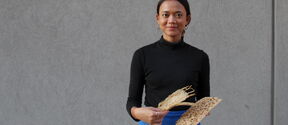High performance man-made cellulosic fibres from old newspapers
The Ioncell-F process developed by Professor Herbert Sixta’s reseach group is a promising environmentally friendly technology for the conversion of low refined waste cellulosic materials, such as waste newsprint, to high-quality man-made cellulosic fibres. This is demonstrated in a study that has been published with a cover image in Green Chemistry Issue 1, 2018.
The growth of the world population and its prosperity alongside with the urbanization of the society have led to a steadily increasing consumption and growth of waste, which creates conflicts between the economic development and the environmental sustainability. Sustainable technologies and production systems are needed to reduce and recycle waste and shift towards a circular economy. Waste paper represents a major part of municipal solid waste. It is primarily recycled as recycled fibre for the manufacture of newsprint. At the same time the textile consumption has been rising dramatically and will need additional supplements to serve the increasing demand for textile products.
From newspaper to iPad
In the study of Professor Sixta’s research group, for the first time in the world, recycled newsprint was successfully converted to man-made cellulose fibres by using dry-jet wet spinning. Old newspapers were deinked and pretreated with an alkaline glycerol to ensure the preparation of spinnable dopes in an novel ionic liquid. The spun fibres exhibited excellent tensile strengths, comparable to commercial Lyocell fibres made from a dissolving pulp. The staple fibres were spun to yarns, dyed and knitted into an iPad cover.
The Ioncell-F innovation opens up new possibilities for the production of regenerated cellulose fibres of the highest quality, taking the principles of green chemistry into account.
More information:
Professor Herbert Sixta
Aalto University
herbert.sixta@aalto.fi
tel. +358 50 384 1764
Read more news

Sebastian Szyller: I want to make machine learning more dependable and resilient to attacks
Sebastian Szyller has been appointed assistant professor at Aalto University Department of Computer Science as from 1 September 2025. He studies how to train privacy-preserving machine learning models, how to safeguard them and ensure robust predictions in untrusted environments
The pilot project for direct article delivery from the National Repository Library ends
Aalto University has been participated in the pilot project for direct article delivery with the National Repository Library and Kopiosto from 2023 to 2025. The pilot ends on 19th December.
From award-winning food packaging to researching biodesign spaces
From an early age, Ena Naito was drawn to both the sciences and design. She found the perfect place to bring those two worlds together.






